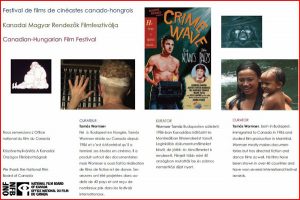November 25th 2010
By Kevin Burns
When Tamás Wormser was asked to assemble the film programme to accompany the Re:InSitu exhibition currently on display at the Saint John Arts Centre in New Brunswick, he knew it was going to be a challenging if not frustrating experience. Why? Because he would have to leave out so many excellent films. To help narrow the field, he chose to focus on filmmakers and not producers, writers, or actors. They will have to wait for another festival that Wormser thinks would be a very interesting experience for audiences.
When he talks about the films accompanying the exhibition Wormser uses the word “traces” several times. In their work, he says he finds many traces of autobiography, regardless of the subject of their film. “You can trace these things. Each of us has had a very different experience. Some of these people were born here, some of them came as kids, and some of us came as young adults. Many filmmakers work with immigrant issues, for example, or being outsiders. There is always some sort of connection to their own personal experience, but the way it plays out is always different.”
That there are so many significant filmmakers in Canada of Hungarian descent is not at all surprising, says, Wormser. “After all, Hollywood was pretty much created by Hungarian Jews. In the 1920s and 30s, the whole idea of Hollywood, the biggest moguls and producers, directors, even extras were Hungarian migrants. This has been going on from the dawn of cinema, this migration, mostly to the U.S., for obvious reasons. Hungary has a huge cinema tradition, and excellent film school.”
As for those filmmakers in his series (Phillip Borsos, Peter Földes, Péter Horváth, István Kántor, Albert Kish, George Mihalka, John Paizs, George Ungár, and Thomas Vámos) he says that their films represent a kaleidoscopic “slice” of Canadian culture, from art film to experimental works. “What I hope people get out of it is how integrated this work is and how it contributes to the making of Canadian culture.”
Wormser has regrets about what he was not able to include in the Re:InSitu programme. Some filmmakers asked not to be included. Others were simply too late: he learned about their work after all the selections had been made. There is also a third “missing” group, and for Wormser it is the most important: producers, specifically that remarkable body of work from such acclaimed Canadian producers as Robert Lantos (Barney’s Version) and Laszlo Barna of Da Vinci’s Inquest fame, and the NFB’s Film Commissioner, Tom Perlmutter. But that would be a whole festival in itself.
In the meantime, Tamás Wormser has two film projects of his own to be concerned about. The Wandering Muse is a theatrical documentary that he hopes to be able to make and which will also be seen on television and available on the Internet. He deals with rootlessness by focusing on “the multifaceted sounds and rhythms expressed in diverse Jewish communities and environments around the world. Through stories, melodies and songs, the film traces the route from sacred to secular,” as he explains on his website. A second project Wormser is working on is a current affairs piece on the situation of the Roma refugees from Hungary.
As the participating filmmakers in Re:InSitu know from their own experience, filmmaking is always expensive, is often a very slow process, and some projects fail to survive that bumpy journey from idea, to funding, to production, to premier screening, to inclusion in a retrospective or themed film programme such as Re:InSitu.
For more on Tamás Wormser and The Wandering Muse: www.thewanderingmuse.net/artesian-films
For more on the Re:InSitu exhibition, including Tamás Wormser’s article on the series included in the exhibition catalogue: www.chaccanada.org


